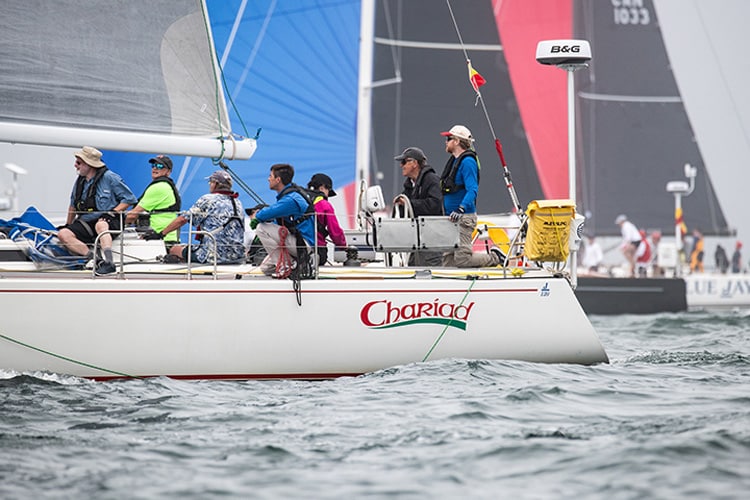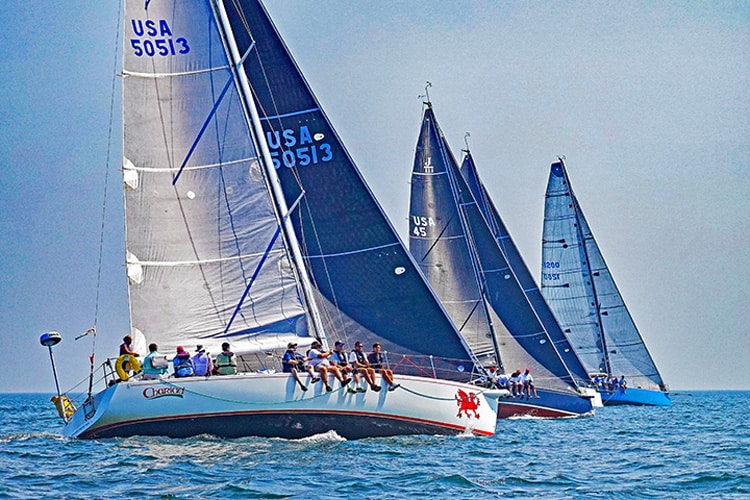Everything I Know About Leadership I Learned on My Sailboat

Yes, I founded and ran a successful company. I went to business school and was a management consultant to companies and government agencies. And, I’ve written a book, Create the Future, about how to make better decisions for your company when you have an exciting opportunity or face a major threat.
Preparing for a challenging sailboat race such as the race from Newport, Rhode Island to Bermuda, and being successful on the water, requires mastery of the full range of leadership and management skills needed to run a successful business. I learn about leadership every time I go racing.
I race CHARIAD, a J/130 sailboat, from Marblehead, Massachusetts. This year, we are doing the Newport to Bermuda race. Crew members are helping prepare the boat for our racing season and training for the high performance racing we do. They are all volunteers who come together to race to win.
To be successful as a leader of your company, you must have a business strategy to compete and win and a business model that delivers a competitive product or service to your customers while making a profit. Racing a competitive sailboat collapses all of these requirements for business and leadership success into one sailing season and into every on-the-water race.
Little kids sail on Optimists. Older men and women cruise and race sailboats worldwide. Professional sailors are celebrities racing high-tech boats in the America’s Cup and other regattas.
Some sailors excel as individuals on their own boats, such as a Laser. For them, the challenge is personal – the physical mastery of the boat by yourself while competing in the complexity of changing wind and waves. Others race on boats such as J/24s with two or three other crew members trimming the sails. A talented skipper can do well directing the crew on sail trim as the wind changes. The skills required for success are the same as those of an entrepreneur or CEO of a startup or small company.
My recent sailboat racing has been on larger boats with eight to ten crew members. As skipper, I cannot tell nine team members what they should be doing every minute of the race. Often, the team members forward on the boat cannot even hear what the skipper is saying. Success requires a leadership structure within the team. We practice and perform as a team with each crew member having a specific role. Crew handling sails on the bow of the boat and those trimming sails in the cockpit operate as largely independent sub-teams.
My role as skipper is to provide overall leadership of the team, communicate goals, and be the orchestra leader signaling when we will tack and jibe. Each team member must know their role
when we launch a spinnaker or tack the boat from port to starboard – wind on the right side of the boat.

To prepare for the race to Bermuda, I divided up responsibilities for getting us to the starting line. Individual crew members were responsible for provisioning, logistics, boat preparation, and safety. We have a Compliance Officer dealing with the race organizer’s requirements and international travel documentation. Each crew member is responsible for training the rest of the crew on specific safety-at-sea procedures such as what to do if a team member falls overboard.
During the race, we divide into two watches responsible for sailing the boat four hours at a time with a watch captain. A navigator is responsible for getting us to Bermuda. The navigator and I, as captain, float between the watches.
Before the race starts Friday afternoon, we will do a computer modeling projection of our fastest course to Bermuda considering the expected wind and current flows over the next five days and our boat’s performance potential. Based on this analysis, we will chart a course above and below the straight line path from Newport to Bermuda. During the race we will adjust our race strategy if conditions change.
Sailboats from around the world come to Newport every other year to race 636 miles to Bermuda (www.BermudaRace.com). About 175 boats will race four or five days across the turbulent Gulf Stream and the vast Atlantic Ocean to a small island far from Europe or America. Every boat must prepare for high wind and no wind and for survival with only what is onboard.
Sailing is a complex combination of technology and performance art. On a normal race day, we closely follow the boat’s speed through the water and its angle to the wind against its performance potential as projected by computer modeling. We are tracking the wind and ocean current patterns in order to best position the boat in the present conditions and the projected future wind and current conditions.
Steering the boat at 3 AM in a deep, cold fog and or high seas calls on different skills. As the skipper, I face two challenges. The first is my personal challenge – how to keep the boat going in these difficult conditions. The second is how to share what I know with the team while also giving the team space to master these skills. I am a good helmsman, but I can only be at the helm for short periods of time. The only way we will get to Bermuda is for the crew to drive us there while sailing the boat at top speed.
Lots of data is on display: boat speed, wind speed, wind direction, heading, etc. When racing, I am monitoring this data and trying to optimize the boat’s performance. I have learned that the lights and swirling data are distracting while I am trying to keep the boat driving at night in difficult conditions. I do better relying on what I am experiencing and sensing – the heel – tilt – of the boat, the wind on my face, the sound of the waves, and the dim line between the fog and the water. Yes, I glance at the illuminated compass to be sure we are on course, but being in touch with my senses is far more important than the distracting lights and data. I sometimes turn them off.
Two other crew members are good helmsmen. We spell each other for the particularly difficult times. Their initial instinct is to depend on the instruments. I coach and encourage them to get in touch with their senses. “May the force be with you.”
The boat must be ready to compete in the challenging conditions we experience at sea, and the crew must be trained to work together as a team. For each race, we must also have a clear strategy for how we will compete given the course, the weather, and our competitor’s capabilities.
Once the race is underway, we must execute our strategic plan, sail the boat to its highest potential, and tactically compete against the other boats.
Preparation, teamwork, strategy, tactics, and performance are the requirements for success for every race as they are for every business.
Every time we race, I grow as a leader. I learn something new about leadership, and I also let the force be with me.
Have you read?
Most Fashionable Countries. Best Countries For Business Expats. Best Non-Native English Speaking Countries. Countries With the Largest Household Size. Best Countries For Older People To Live In.
Bring the best of the CEOWORLD magazine's global journalism to audiences in the United States and around the world. - Add CEOWORLD magazine to your Google News feed.
Follow CEOWORLD magazine headlines on: Google News, LinkedIn, Twitter, and Facebook.
Copyright 2025 The CEOWORLD magazine. All rights reserved. This material (and any extract from it) must not be copied, redistributed or placed on any website, without CEOWORLD magazine' prior written consent. For media queries, please contact: info@ceoworld.biz








